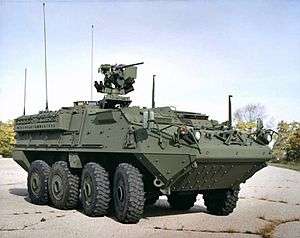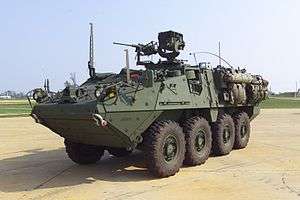M1126 Infantry Carrier Vehicle
| M1126 Infantry Carrier Vehicle | |
|---|---|
|
Stryker ICV.[1] | |
| Specifications | |
| Weight | 16.47 t (18.12 ST) |
| Length | 6.95 m (22 ft 10 in) |
| Width | 2.72 m (8 ft 11 in) |
| Height | 2.64 m (8 ft 8 in) |
| Crew | 2+9 |
|
| |
| Armor | 14.5 mm resistant[1] |
Main armament | 0.5 inch (12.7 mm) M2 Browning machine gun or 40 mm Mk 19 grenade launcher or four M6 smoke grenade launcher mounted in a Protector Remote Weapon Station (ICV) |
Secondary armament | .50-inch M2 MG and 7.62 mm M240 machine gun (MGS) |
| Engine |
diesel 260 kW (350 hp) |
| Power/weight | ICV: 15.8 kW/t (19.3 hp/sh tn) |
| Suspension | 8×8 wheeled with hydrostrut leaf spring |
Operational range | 500 km (310 mi) |
| Speed | 100 km/h (62 mph) |
The M1126 Infantry Carrier Vehicle (ICV) is an armoured personnel carrier and part of the Stryker family of vehicles (derived from the Canadian LAV III/Swiss MOWAG Piranha IIIH 8x8) used by the United States Army.
General
The Infantry Carrier Vehicle provides protected transport and, during dismounted assault, supporting fire for the infantry squad. The Stryker is a full-time four-wheel drive, selectively eight-wheel drive, armoured vehicle weighing approximately 19t which carries an infantry squad with their equipment. On paved roads the vehicle can attain speeds of 62 mph without a governor and 37 mph with a governor.
The basic infantry carrier vehicle (ICV) provides armored protection for the two-man crew and a squad of nine soldiers.
Digital communications system
The vehicle's commander has an FBCB2 (Force XXI Battle Command Brigade and Below) digital communications system that allows communication between vehicles through text messaging and a map network, as well as with the battalion. The map shows the position of all vehicles on the battlefield and the commander can mark the position of enemy forces on the map, which can then be seen by other commanders.
Armament
The M1126 ICV has a Protector remote weapon station with a universal soft mount cradle, which can mount either a .50 caliber M2 Browning machine gun, a 40mm MK19 grenade launcher or a 7.62×51mm NATO M240 machine gun. It is also armed with four M6 smoke grenade launchers.
Army officials plan to up-gun Stryker ICVs with a 30 mm cannon in a Kongsberg Protech Systems' Medium Caliber Remote Weapons Station (MCRWS),[2] which does not extend into the crew compartment and take up space and can be loaded from inside.[3] Test firings occurred on a Stryker demonstrator on 19 February 2014, showing increased lethality and accuracy over the standard .50-caliber machine gun at ranges from 600-1,550 meters; the 30 mm cannon is capable of hitting targets over 2,000 meters away.[4]
After comparative testing of the Kongsberg MCRWS mounted to Strykers, the U.S. Army approved on 22 April 2015 the equipping of 81 of the 2nd Cavalry Regiment's Stykers with 30 mm cannons following a lethality upgrade request to increase lethality against other light armor vehicles while preserving its wheeled mobility advantages.[5][6] Outfitting the first Strykers with Mk44 Bushmaster II cannons is planned to occur in the next two years.[7] The first upgraded ICV, designated XM1296 "Dragoon," was delivered for testing on 27 October 2016, with fielding to begin in May 2018.[8]
Gallery
 Interior control station for Protector M151 Remote Weapon Station in Stryker ICV
Interior control station for Protector M151 Remote Weapon Station in Stryker ICV Remote Weapon Station on Stryker ICV
Remote Weapon Station on Stryker ICV- Stryker ICV on patrol in Iraq
See also
References
- 1 2 "Army Fact File - Stryker". Retrieved 2006-07-31.
- ↑ Army Looks to Mount 30mm Cannons on Strykers - Military.com, 20 September 2013
- ↑ Army to Test Kongsberg’s New Gun on Stryker - Defensetech.org, 21 October 2013
- ↑ Stryker demonstrates potential for increased lethality - Army.mil, 26 February 2014
- ↑ The 30 Millimeter Solution: Army Upgunning Strykers Vs. Russia - Breakingdefense.com, 23 April 2015
- ↑ US Troops in Europe Request Bigger Guns Amid Tensions With Russia - Military.com, 27 April 2015
- ↑ US Army: Strykers Need Bigger Gun to Fight Russia - Defensenews.com, 24 July 2015
- ↑ Army receives first Stryker upgraded with 30mm cannon - Armytimes.com, 28 October 2016
This article incorporates work from http://www.sbct.army.mil/product_icv.html,[] which is in the public domain as it is a work of the United States Military.

